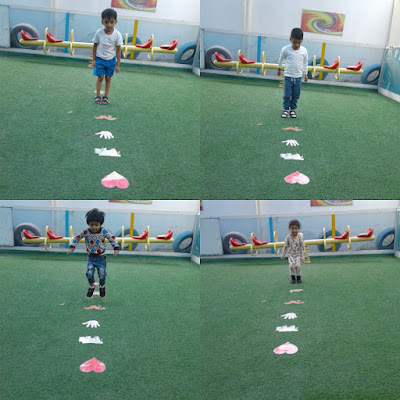End of the First Term
OUR BABIES
Babies are born social
creatures. From their earliest days, they begin to connect to and collect
information from their caregivers. In fact, even newborns are capable of
imitating facial expressions, demonstrating an understanding of how another’s
actions relate to their own. Until approximately a baby’s first birthday, he and his
primary caretaker are often immersed in an intimate dyad of love and learning.
Babies seek a relationship that engenders trust, security, and a sense of
optimism. If they succeed, they will have mastered the basic psychosocial goals
of this age and will advance in development with a strong and secure sense of
the world and their place within it. For it is only from a place of secure
attachment that a baby is safe enough to explore the larger world around her.













OUR PLAYGROUP I
Around the age of one, toddlers become more interested in
exploration. They develop a more sophisticated understanding not only of other
people and things, but also themselves. This is also the time when
stranger anxiety begins, where toddlers hang back with less well-known adults. They also show displeasure (at least initially) when their primary caretakers
leave the room or put them in the care of another. According to British
psychologist John Bowlby, this attachment serves a useful function. That is, it
allows a sort of equilibrium between a toddler’s increasing need to venture out
and explore, and his need for a secure base to protect and guide him.
OUR PLAYGROUP II
Around the age of
two, we see the full appearance of a child’s will. Parents’
patience with and ability to successfully respond to a child’s will affects the
outcome of this stage. It is during this stage that children develop their
first interests, and an increased desire for autonomy. With encouragement,
children explore and expand on these interests and drives. They develop
self-sufficient behavior (e.g., begin to dress themselves, feed themselves,
etc.), and a sense of autonomy. With punishment, punitive responses, or demands
that are beyond the child’s capabilities, they retreat into shame and doubt.
























OUR FOUNDATION YEAR
By the time Children turn three, they are quite good
at reading facial expressions. Most children this age can articulate how
another will feel if they don’t get a coveted toy (disappointed) or if they are
left alone (scared). Foster your child’s understanding of basic emotions
by talking to them about how people cry or frown when they are sad, how they
smile and laugh when they are happy, how their eyes get big and they tend to
withdraw when they are scared, etc. Don’t forget to use words like frustrated
or worried, to allow them to begin to understand more subtle emotions as well.
By providing a cluster of clues in this way, you support your child’s
developing understanding of this relatively complex topic. The goal is
for your child to have a secure base, a strong and nurturing primary
relationship, and a spirited drive to explore and experiment. From here they
will begin to seek out experiences and others to expand their world and enlarge
their sphere of influence.




















































































































































No comments:
Post a Comment